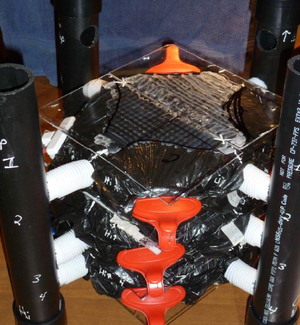J.M.Pearce (talk | contribs) m (→Abstract) |
J.M.Pearce (talk | contribs) mNo edit summary |
||
| Line 1: | Line 1: | ||
{{MOST}} | {{MOST}} | ||
[[image:hrv.png|right|300px]] | |||
==Source== | ==Source== | ||
* D. Denkenberger, M. Parisi, J.M. Pearce. “Towards Low-Cost Microchannel Heat Exchangers: Vehicle Heat Recovery Ventilator Prototype” ''Proceedings of the 10th International Conference on Heat Transfer, Fluid Mechanics and Thermodynamics (HEFAT)'', 14-16 July 2014, Orlando, FL, USA. [open access soon] | * D. Denkenberger, M. Parisi, J.M. Pearce. “Towards Low-Cost Microchannel Heat Exchangers: Vehicle Heat Recovery Ventilator Prototype” ''Proceedings of the 10th International Conference on Heat Transfer, Fluid Mechanics and Thermodynamics (HEFAT)'', 14-16 July 2014, Orlando, FL, USA. [open access soon] | ||
| Line 7: | Line 7: | ||
==Abstract== | ==Abstract== | ||
Vehicles could save ~110 million gallons of gasoline per year in the U.S. with heat exchangers acting as [[heat recovery ventilators]] in the air conditioning systems. Even more energy could be saved with in-vehicle heat exchangers by reducing heating energy in plug-in vehicles. Currently, vehicles do not have heat recovery ventilators because of the high cost of conventional metal heat exchangers. To overcome this challenge, low-cost expanded polymer microchannel [[heat exchangers]] were studied. Forward conduction laser welding was used to join 25-micron thick linear low-density polyethylene sheets, which were then fixed into shape and expanded. The microchannel polymer heat exchangers were tested at various air flow rates. At the maximum flow rate, the effectiveness was ~70% and the implications of this expanded heat exchanger in other applications are discussed. | [[image:vehicle hrv.png|left]] Vehicles could save ~110 million gallons of gasoline per year in the U.S. with heat exchangers acting as [[heat recovery ventilators]] in the air conditioning systems. Even more energy could be saved with in-vehicle heat exchangers by reducing heating energy in plug-in vehicles. Currently, vehicles do not have heat recovery ventilators because of the high cost of conventional metal heat exchangers. To overcome this challenge, low-cost expanded polymer microchannel [[heat exchangers]] were studied. Forward conduction laser welding was used to join 25-micron thick linear low-density polyethylene sheets, which were then fixed into shape and expanded. The microchannel polymer heat exchangers were tested at various air flow rates. At the maximum flow rate, the effectiveness was ~70% and the implications of this expanded heat exchanger in other applications are discussed. | ||
==See Also== | ==See Also== | ||
Revision as of 12:49, 22 July 2014

Source
- D. Denkenberger, M. Parisi, J.M. Pearce. “Towards Low-Cost Microchannel Heat Exchangers: Vehicle Heat Recovery Ventilator Prototype” Proceedings of the 10th International Conference on Heat Transfer, Fluid Mechanics and Thermodynamics (HEFAT), 14-16 July 2014, Orlando, FL, USA. [open access soon]
Abstract

Vehicles could save ~110 million gallons of gasoline per year in the U.S. with heat exchangers acting as heat recovery ventilators in the air conditioning systems. Even more energy could be saved with in-vehicle heat exchangers by reducing heating energy in plug-in vehicles. Currently, vehicles do not have heat recovery ventilators because of the high cost of conventional metal heat exchangers. To overcome this challenge, low-cost expanded polymer microchannel heat exchangers were studied. Forward conduction laser welding was used to join 25-micron thick linear low-density polyethylene sheets, which were then fixed into shape and expanded. The microchannel polymer heat exchangers were tested at various air flow rates. At the maximum flow rate, the effectiveness was ~70% and the implications of this expanded heat exchanger in other applications are discussed.

